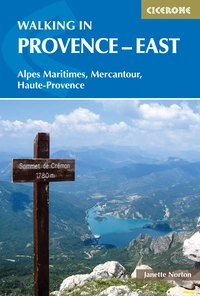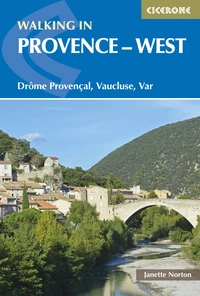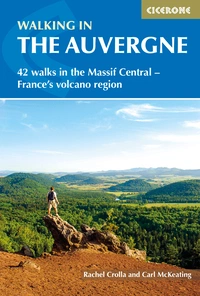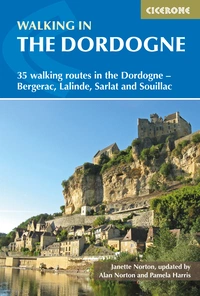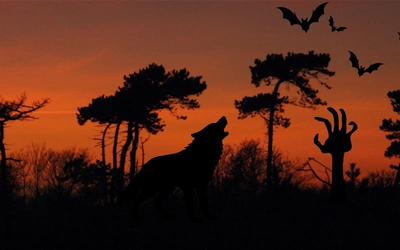Spring and autumn in the Drôme Provencale
Local trek leader Hilary Sharp highlights the best places to walk in spring and autumn in the Drôme Provençale area of southern France, including Mont Ventoux, Saint Julien, Montagne la Banne and Rocher de Caire from charming villages like Le Poët Sigillat and Buis les Baronnies.
When you think of Provence what’s the first thing that comes to mind? Images of the Mediterranean coast, fields of lavender, hot balmy days sipping rosé at a café in a typical French village square with small plates of olives, aioli, and baguette? A steaming dish of bouillabaisse or an omelette garnished with shavings of black truffles? Provence certainly does offer all these delights, but for the keen walker it offers so much more.
The region of Provence extends from the left bank of the lower Rhône on the west to the Italian frontier on the east, and is bordered by the Mediterranean to the south. Settled by the Greeks in the 6th century BC, the area around Marseilles became, in the 1st century BC, part of the Roman colony of Gaul. It was united with France in the late 15th century. The name comes from the Latin provincia 'province', a colloquial name for southern Gaul, the first Roman province to be established outside Italy.
Several French départements or counties are now considered a part of this large region, including Provence Côte d’Auz, the Vaucluse and the Drôme. This takes the northern boundary of Provence up to the alpine limestone foothills of the Vercors, more than 200kms from the Mediterranean coast.
Although the coast itself has been heavily developed, leaving few wild spaces, only a few kilometres inland there is still plenty to excite the nature lover. Hills rise up immediately to form wide plateaus, scoured with deep rocky gorges, with tiny ancient villages clinging to the steep sunny slopes. There is lots of walking, much of it well-signed thanks to the French Fédération de la Randonnée Pédestre. One of the famous Grande Randonnées (GR4) starts in the perfume capital of Grasse, not far from the world renowned hotels and casinos of Cannes. This long-distance trek goes all the way from the Mediterranean to the Atlantic coast (at Royans), crossing through much of southern and central Provence in the process, including the famous Verdon Gorge, with its huge vertical walls, much loved by climbers.
Many English visitors discovered the delights of this part of France through Peter Mayle’s book A Year in Provence which described an idyllic life in a French village from the viewpoint of a British couple who bought a home there, and in the last three decades there has been an influx of foreigners doing just that in Southern Provence. Northern Provence, however, is a different deal. We can define this area as being on the shady side of Grasse, not far from the world renowned hotels and casinos of Cannes. This long-distance trek goes all the way from the Mediterranean to the Atlantic coast (at Royans), crossing through much of southern and central Provence in the process, including the famous Verdon Gorge, with its huge vertical walls, much loved by climbers.
Mont Ventoux itself offers fabulous walking, despite there being two roads to the summit. The GR4 makes its way over the top and there are numerous trails on both sides which allow walkers to start some way up the peak and to enjoy the superb views which on a clear day stretch all the way to Mont Blanc (so they say!). But there is so much more to discover in the wild and remote Drôme Provençale. Whether you’re looking for full-on summit climbs, valley strolls, gorge walks, or village-to-village exploration, the walks in this region will keep you occupied for a lifetime – which for me is a good thing as this is now my home!

The best times to walk here are probably April/May and September/October. The trees begin to blossom late March, the first being the pink and white almond blossom, quickly followed by the cherry and apricot trees. The days are long and the temperatures should be perfect for walking. Many walks begin in tiny medieval villages, often perched high above the valleys. In the past these villages were situated to take advantage of sunny pastures and defensive positions where approaching marauders would be spotted in plenty of time; they were linked by mule trails used for centuries in preference to travelling through the lower valleys which were often prone to floods, landslides and ambush.
The village of Le Poët Sigillat is a perfect example and from here numerous trails lead into the surrounding hills giving beautiful views of the long wide Ennuye Valley. Equally fine is the somewhat isolated village of Le Poët en Percip which is situated far from anywhere, way up the Menon Valley. From here the wide summit of Montagne la Banne can be climbed. This remote peak is only 1382m high but gives a fabulous panoramic views, dominated by the nearby northern slopes of Mont Ventoux but also encompassing the whole of the Baronnies basin and the peaks to the north, including the long summit of Angèles the highest in the northern region. The whole walk is steeped in history, with ancient dwellings being visible in a small valley en route.
The only thing Le Poët Sigillat and Le Poët en Percip lack are cafés with a sunny terrace for the post-walk beer. These villages have a very small population now. Before the two World Wars they would have been thriving centres but with the loss of so many men it was difficult for these communities to survive and many families were forced to head for the big cities in search of work. (The word Poët has nothing to do with rhyming verse; it’s a local word describing a promontory.)
The bustling small town of Buis les Baronnies, also a base for many fine walks, still has its cafés. A new and somewhat controversial Parc Naturel des Baronnies is currently in its very early days, the idea being to protect and promote this area of northern Provence which stretches from Nyons and Buis les Baronnies over to Sisteron and the boundary with the Haute Alpes. Buis les Baronnnies itself is famous for its tilleul (linden) trees and has an attractive old centre with ancient arcades. From here you can do a beautiful circuit around the remarkable limestone fin of Saint Julien, which has many great rock-climbs as well as a series of new and popular via ferrata routes along its narrow ridgeline.

Autumn is the time for that famous Provence light, so much sought after by artists. And once again the temperature is perfect for walking. After the grapes are picked the vines soon change colour as do many of the trees along the valleys. This is a good time to do a hike up to a high ridge or plateau to see the Griffin vultures which have been reintroduced in various regions of Provence, notably above the Eygues River at Remuzat. There’s a great walk starting and finishing in Remuzat village which takes a very improbable route up through the cliffs, with a short section of cables and a ladder. Once at the top of the Rocher de Caire the views are fabulous and you’re pretty sure to see the vultures putting on a show.
This is also a good time to tick off some of the summits that are too hot in the summer months. There are numerous peaks to go at, several of them around the charming village of Nyons, famous for its unique black olives – olive groves and mills abound and it’s definitely worth factoring in time to visit and sample the exquisite oil. Peaks such as Cougoir offer excellent walking with great views out west towards the Rhône Valley.
Even in winter there are plenty of walking opportunities. In fact this past winter we hiked up to the Dentelles de Montmirail range, just to the south-west of Mont Ventoux, in 20 cms of fresh snow, and the views were truly magnificent.
Provence provides the full package of beautiful scenery, wonderful trails, a deep and complex history that has produced a rich culture and wealth of regional specialties – from dishes using the abundant locally-sourced produce to wines that encapsulate the sun-kissed climate to crafts and crops which have evolved from centuries of farming and cultivating in this wild and fruitful environment. And the best way to discover it all is on foot.



